In the realm of manufacturing and engineering, few machines have revolutionized the way we shape and mold materials as CNC milling machines. And we always look for precision in that!
There exists a difference between exactly meeting the specification and almost meeting it; this is where the milling machines come in!
Before going into depth about the milling machine components and working principle, let’s overview the CNC milling machines.

CNC milling machines are a common and widely used CNC machine used to drill and cut shapes into a hard solid material.
These machines make cuts that are known as "milling" The cutting spindle remains stationary while the part moves to work in X, Y, and Z axes.
The core function of the CNC milling machine is to produce custom-designed parts by progressively removing the material from the workpiece using rotating multi-point cutting tools and computerized controls.
These computer controls involve digitized data to monitor and control the machine’s movement.
With chemical, electrical, mechanical, and thermal production capabilities, CNC milling machines are used in automotive manufacturing, woodworking, the electrical industry, and more.
CNC Milling machine produces complicated parts for industries using subtractive machine technology. The machine cuts the workpiece and crafts the final piece using 3, 4, or 5 axes.
The complexity of the final piece depends on the number of axes the machine has. Hence, it has various applications in medicine as well as aerospace industries.
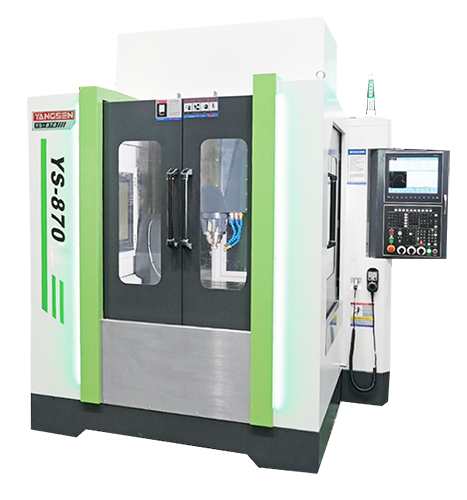
Now, let’s explore the major components of a CNC milling machine.
The input device includes the devices used to enter programming data into the CNC machine. They include punch tape readers, magnetic tape readers, and computers connected through RS-232-C.
Calling MCU the brain of the CNC milling machine won’t be wrong. It carries out all of the CNC machine operations. It decodes the coded instructions and reads them for jobs. The axes employ linear, helical, and spherical interpolation to create motion commands.
It also generates precise motion signals based on instructions received from the CNC program. It controls the motion of the machine axes X, Y, and Z.
MCU calculates the acceleration, speed, and deceleration, ensuring the smooth movement of the components.
The machine Control Unit also controls the spindle and receives feedback from various sensors.
Additionally, it coordinates the movements of the cutting tool and the workpiece, ensuring accurate machining.
The drive system is important among the CNC milling machine components as it provides the power to move the machine’s axes and perform the milling operations.
It constitutes motors, ball screws, drive amplifiers, linear guides, and belts.
All these parts work together to execute the commands from the Machine control unit and move the machine's axes in a coordinated manner. The drive’s accuracy and responsiveness are crucial for efficient machining operations.
Machine tools include devices that cut and shape the workpiece to create the desired shape. They are attached to the machine spindle and are controlled by the CNC system to perform milling operations.
Common milling tools include end mills, face mills, drills, reamers, taps, boring tools, thread mills, and more.
The feedback mechanism provides information about the machine’s position and other relevant parameters. It assists the control system to ensure accuracy and precision.
A few feedback mechanisms used in CNC milling machines include encoders, linear scales, probes, limit switches, spindle load monitors, coolant level sensors, tool breakage detection, and more. They all are used to monitor different parameters that combine to give accuracy in machining operations.
The display unit is the operator and CNC control system interface. It offers visual feedback to the operator allowing them to monitor and control the operations.
The critical aspects of the display unit in the milling machine include a display screen, status information, user interface, program and tool display, alarm and error messages, and diagnostic information.
The bed is the horizontal, flat surface on which the workpiece is placed during the process. It provides a smooth, stable space for holding the workpiece in place for its shaping.
The critical aspects of the bed of the CNC milling machine include T-slots, material, work envelop, Workpiece Alignment and Fixturing, Coolant and Chip Management, and Enclosure and Safety.
The headstock holds and drives the cutting tool. It is located at one end of the machine and rotates the tool while the workpiece remains static.
The headstock consists of a spindle that mainly holds and rotates the tool at high speed for cutting it.
The other parts include tool holders, motors, bearings, and tool-changing systems. In a nutshell, the headstock provides the necessary rotational movement while holding the piece securely.
Among the CNC milling machine components, the tailstock is important as it offers stability to the workpiece. It is present at the opposite of the headstock.
As mentioned above, the headstock rotates the workpiece, so this tailstock part helps maintain its alignment.
The tailstock consists of the following key elements: body, quill, quill handle, locking mechanism, and tailstock spindle.
The pedal, also known as the footswitch, is an optional feature for additional functions. The pedal in a CNC milling machine can be used as a footswitch, feed control pedal, and emergency stop pedal.
Chuck is a device that is used to hold the workpiece while the cutting process. It is mounted on the machine’s spindle and rotates the workpiece or tool as required during machining.
Many types of chuck are used according to the machine and the cutting requirements.
It is the interface through which an operator interacts with the machine and controls its various functions. It has physical buttons, knobs, switches, and a display screen.
Typically, you will see these functions and buttons on the control panel of a CNC milling machine. Power on/off, Emergency stop, Mode selection, jogging control, spindle control, feed rate control, display screen, program input, and function buttons.
Working Principle of CNC Milling Machine
The working principle of a CNC milling machine involves how all components and processes work together to carry out the machining process successfully.
Let’s dig in to learn more about it!
The process begins with creating a digital model of the desired part using CAD software. Then it is used to generate a machining program that defines the tool paths and other instructions required for the milling operation.
Then the workpiece is mounted on the fixture, and the appropriate cutting tool is installed in the spindle. The operator ensures that the workpiece, and machine settings are aligned correctly.
The machine is powered on, and the program is loaded into the control system. This program consists of G-code with instructions about moving the tool in multiple (X, Y, Z) axes.
The stepper motor drives the X, Y, and Z axes, sometimes rotational or tilting. The movement of the tool depends on the movement of these axes' appropriateness.
As the tool moves progressively, it cuts and shapes the material into the desired output. The cutting depth and speed can be adjusted to optimize the machining process.
You may also apply lubricant during the cutting and workpiece to reduce friction and improve chip evacuation 8or it can also be automated).
The feedback system provides real-time information about the machine’s position and other variables. You may also make adjustments to take corrective measures accordingly.
Once the machining operation is complete, the machine may perform additional actions, such as tool changes, workpiece inspection, or measurements. These actions ensure the accuracy and quality of the machined part.
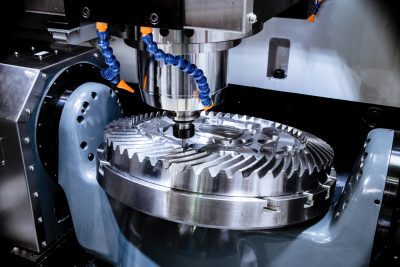
There can be several types of CNC milling operations, including the following.
Plain milling also known as surface milling is a column and knee operation and is used for milling plain surfaces. It involves removing material from the workpiece’s surface using the cutter with multiple teeth.
It involves cutting material from the face of a workpiece to create a smooth flat surface. A face milling cutter is used to perform face milling which has cutting edges on the periphery and also on the face of the cutter.
It involves milling flat surfaces at an angle other than 90 degrees, the process is similar to plain milling. The only difference between the two is the angular setup. It is used to create angular surfaces, chamfers, bevels, etc.
Form milling involves cutting the workpiece using a specially designed milling cutter or form cutter. It is customized to create a specific shape on the workpiece that allows the production of specific features.
Gang milling involves using multiple milling cutters mounted on the same arbor to cut multiple surfaces simultaneously. It is used to produce complex shapes in a single setup.
Other than these CNC milling operations there are other types as well that include Slide and Slot milling operations.
Now, let’s explore the major features of the CNC milling machine.
It is the heart of a CNC milling machine. It interprets the machining program and controls its operations, ensuring precise and accurate axes, spindle, and feed rate movements.
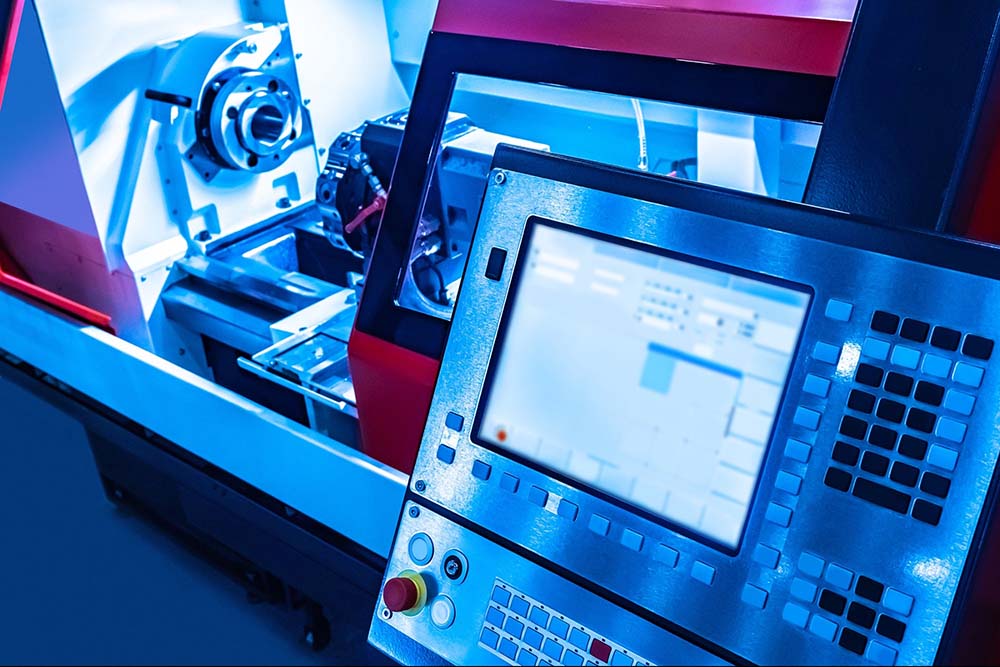
It is another fundamental feature of a CNC milling machine. The X, Y, and Z axes provide the ability to move the cutting tool in multiple directions, enabling the creation of complex shapes and contours.
A powerful and versatile spindle with adjustable speed and torque allows for efficient material removal and the ability to work with various cutting tools. A robust and efficient tooling system, including an automatic tool changer, enhances productivity by enabling quick tool changes during machining operations.
It provides an interface to interact with the CNC milling machine. An intuitive and user-friendly control panel with clearly labeled buttons, switches, and a display screen facilitates easy programming, monitoring, and adjustment of machining processes.
Effective coolant and chip management systems are essential features of CNC milling machines. Coolant systems apply coolant or lubrication to the cutting tool and workpiece, dissipating heat, reducing friction, and improving tool life and surface finish. Chip management systems, such as chip conveyors or augers, efficiently remove chips from the machining area, preventing chip accumulation and ensuring uninterrupted machining.
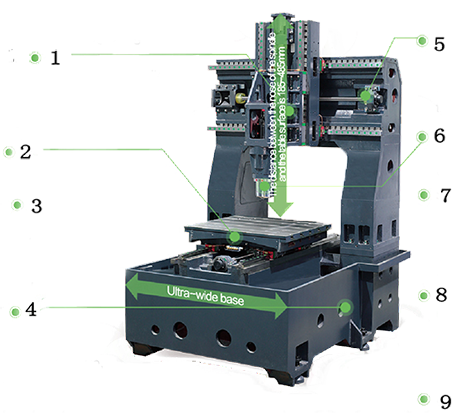 |
1. A patented spindle box of engraving and milling machine There is a stepped hole inside the spindle box; the electric spindle is installed in the stepped hole, and a flange is used to fix the spindle box 2. Worktable Box structure and ballscrew are integrally formed. 3. Optical linear scales Optional Heidenhain, Fagor optical linear scales with accuracy of under ±5um 4. Base Multi-layer wall box structure, rear chip extractions 5. A triangular rib structure of bridge column The utility model of the triangular rib structure of the door bridge improves the dynamic and static rigidity of the machine tool and enhances the processing accuracy. 6. Optional Direct-Driven BBT40 spindle 7. Upgrade Configuration Standard servo carousel tool magazine; HSK-E40 motor spindle; graphite protection package; laser tool probe; oil mist collector system, and more 8. Stable Accuracy The closed loop optical linear scales with high positioning accuracy can effectively suppress the positioning error caused by the thermal extension of the lead ballscrew. 9. System Stability Equipped with Siemens 828D system. |
As CNC milling machines are versatile, they have various applications in various industries. A few common applications include:
CNC milling machines are used to machine various materials such as metals, plastics, and composites, allowing for the production of complex shapes and parts. They are extensively used in manufacturing industries for producing precision parts and components.
CNC machines have numerous applications in the aviation industry as they manufacture critical components like turbine blades, aircraft structures, and versatile gear while maintaining safety and high precision.
Automobile industries use Milling machines to produce engine components, transmission parts, chassis components, and interior and exterior trim parts. They enable efficient production and high-quality production of complex automotive parts.
CNC milling machines are employed in the electronics industry for manufacturing printed circuit boards, housing components, connectors, and other electronic parts. They offer precise machining capabilities for creating intricate designs and patterns on printed circuit boards and other electronic components.
As precision and accuracy are crucial in the medical industry, so do CNC milling machines. They are used to make surgical instruments, dental components, and medical device parts.
In prototyping or rapid manufacturing processes where functional parts are required quickly, CNC milling machines come into use as they offer fast turnaround, efficient iterations, and cost-effective productions.
CNC milling machines manufacture tools and die-making to produce dies, molds, and fixtures. Precise machining processes allow accurate and repeatable production processes.
CNC milling machines are used to create intricate and detailed designs on precious metals. They allow precise cutting and shaping of the pieces at the commercial level.
Milling machines are extremely useful for teaching and conducting engineering, manufacturing, and materials science research as they offer hands-on training in manufacturing innovative parts.
This article covers the overview and basics of CNC milling machines. They are commonly used to drill and cut shapes into a hard solid material.
Additionally, it also covers what and how a CNC milling machine works. Its working principle has been explained in detail above.
Whether it’s the automotive industry or any other department requiring accurate and precise parts at lower cost with fast turnaround, CNC machines are the best choice!
If you also are looking for an excellent CNC milling machine for greater efficiency, look no further and get a CNC milling machine based on your requirements and desire from Yangsen!
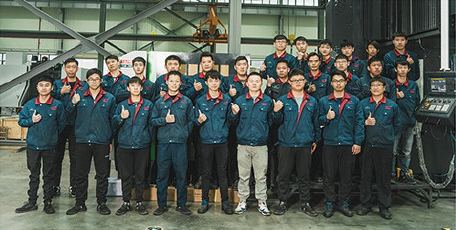
Suggest reliable CNC milling machine manufacturers.
It is recommended to buy milling machines from Yangsen. They offer a wide range of reliable CNC milling machines.
What are the uses of CNC milling machines?
CNC milling machines are widely used in medical, automotive, aerospace, jewelry, and die-making.
What are the advantages of using a CNC milling machine?
● No waste
● High precision and accuracy
● Fast turnaround
● Reduced energy consumption
● Personnel safety